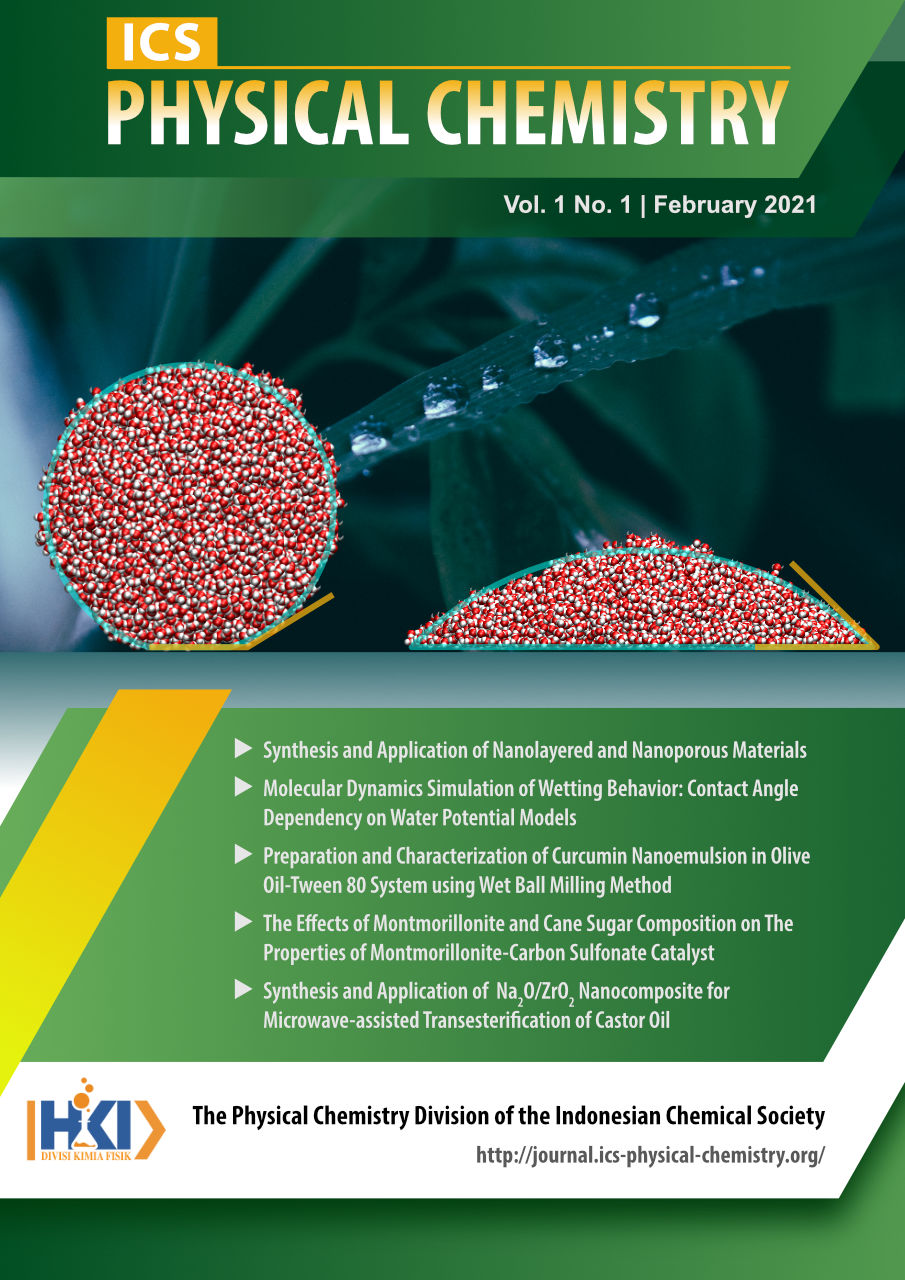Preparation and Characterization of Curcumin Nanoemulsion in Olive Oil-Tween 80 System using Wet Ball Milling Method
Main Article Content
Abstract
Nanoemulsion has been developed as a drug delivery system which increases bioavailability and effectiveness of curcumin. Many methods and formulations have been applied in order to fabricate the most efficient nanoemulsion system to deliver curcumin. Wet ball milling is a simple technique to grind solids like powder to produce nano emulsion. On the other hand, a combination of olive oil and curcumin in Mediterranian Diet shows a promising anticancer activity. This research aims to elaborate the preparation and characterization of curcumin nanoemulsion in olive oil-Tween 80 system with wet ball milling method. It is expected that the procedure yields a combination of curcumin and olive oil in nanoemulsion system with simple preparation. This research uses curcumin as active compound, olive oil as solvent for curcumin, Tween 80 as stabilizer, and water as dispersing agent. Particle size and polydispersity index are determined using Dynamic Light Scattering technique. The results show that the best milling time is 8 hours to produce nanoemulsion that has diameter of 303 nm and polidispersity index of 0.29. Nanoemulsion system is stable for 60 days storage at 4 oC and 25 oC. The maximum curcumin mass that can be loaded in the system while maintaining particle size in nanoemulsion range is 300 mg.
Article Details

This work is licensed under a Creative Commons Attribution-NonCommercial-NoDerivatives 4.0 International License.
References
S. Zorofchian Moghadamtousi, H. Abdul Kadir, P. Hassan- darvish, H. Tajik, S. Abubakar and K. Zandi, A Review on Antibacterial, Antiviral, and Antifungal Activity of Curcumin, BioMed Research International, 2014, 2014, 1–12.
D. J. Den Hartogh, A. Gabriel and E. Tsiani, Antidiabetic Properties of Curcumin II: Evidence from In Vivo Studies, Nutrients, 2019, 12, 58.
M. Tomeh, R. Hadianamrei and X. Zhao, A Review of Curcumin and Its Derivatives as Anticancer Agents, International Journal of Molecular Sciences, 2019, 20, 1033.
J. S. Jurenka, Anti-inflammatory properties of curcumin, a major constituent of Curcuma longa: a review of preclinical and clinical research, Alternative Medicine Review: A Journal of Clinical Therapeutic, 2009, 14, 141–153.
A. A. Esperón-Rojas, R. Baeza-Jiménez, D. Santos-Luna, L. d. C. Velasco-Rodríguez, L. R. Ochoa-Rodríguez and H. S. García, Bioavailability of curcumin in nanoemulsions stabilized with mono- and diacylglycerols structured with conjugated linoleic acid and n-3 fatty acids, Biocatalysis and Agricultural Biotechnology, 2020, 26, 101638.
A. A. Ochoa-Flores, J. A. Hernández-Becerra, A. Cavazos- Garduño, I. Soto-Rodríguez, M. G. Sanchez-Otero, E. J. Vernon-Carter and H. S. García, Enhanced Bioavailability of Curcumin Nanoemulsions Stabilized with Phosphatidylcholine Modified with Medium Chain Fatty Acids, Current Drug Delivery, 2017, 14, 377–385.
H. Yu and Q. Huang, Improving the Oral Bioavailability of Curcumin Using Novel Organogel-Based Nanoemulsions, Journal of Agricultural and Food Chemistry, 2012, 60, 5373– 5379.
A. Borzì, A. Biondi, F. Basile, S. Luca, E. Vicari and M. Vacante, Olive Oil Effects on Colorectal Cancer, Nutrients, 2018, 11, 32.
T. Esposito, C. Schettino, P. Polverino, S. Allocca, L. Adelfi, A. D’Amico, G. Capaldo, B. Varriale, A. Di Salle, G. Peluso, G. Sorrentino, G. Lus, S. Sampaolo, G. Di Iorio and M. Melone, Synergistic Interplay between Curcumin and Polyphenol-Rich Foods in the Mediterranean Diet: Therapeutic Prospects for Neurofibromatosis 1 Patients, Nutrients, 2017, 9, 783.
A. E. Kamel, M. Fadel and D. Louis, Curcumin-loaded nanostructured lipid carriers prepared using PeceolTM and olive oil in photodynamic therapy: development and application in breast cancer cell line, International Journal of Nanomedicine, 2019, 14, 5073–5085.
B. Sharma, J. Kaur and M. Singh, Ultrasound Assisted Curcumin Nanoformulation Imparting Enhanced Functionality, July 11-12, 2017 Bangkok (Thailand) Back LHHISS-17, FCBHS-17, ASET-17, 2017.
J. S. Franklyne, A. Nadarajan, A. Ebenazer, N. Tiwari, A. Mukherjee and N. Chandrasekaran, PREPARATION AND CHARACTERIZATION OF EDIBLE OIL NANOEMULSIONS FOR ENHANCED STABILITY AND ORAL DELIVERY OF CURCUMIN, International Journal of Applied Pharmaceutics, 2018, 10, 139.
G. Páez-Hernández, P. Mondragón-Cortez and H. Espinosa- Andrews, Developing curcumin nanoemulsions by high-intensity methods: Impact of ultrasonication and microfluidization parameters, LWT, 2019, 111, 291–300.
S. I. Sholihat, E. Indahyanti, M. L. A. Lestari and Z. Ningsih, Preparation of Curcumin Nanoemulsion in Soybean Oil – Tween 80 System by Wet Ball Milling Method, IOP Conference Series: Materials Science and Engineering, 2020, 833, 012044.
D. Y. Shelat and S. R. Acharya, CUR-CA-THIONE: A NOVEL CURCUMIN CONCOCTION WITH ENHANCED WATER SOLUBILITY AND BRAIN BIO-AVAILABILITY, International Journal of Pharmacy and Pharmaceutical Sciences, 2016, 8, 265–270.
M. Li, M. Azad, R. Davé and E. Bilgili, Nanomilling of Drugs for Bioavailability Enhancement: A Holistic Formulation- Process Perspective, Pharmaceutics, 2016, 8, 17.
Z. H. Loh, A. K. Samanta and P. W. Sia Heng, Overview of milling techniques for improving the solubility of poorly water-soluble drugs, Asian Journal of Pharmaceutical Sciences, 2015, 10, 255–274.
A. Otte and M. T. Carvajal, Assessment of Milling-Induced Disorder of Two Pharmaceutical Compounds, Journal of Pharmaceutical Sciences, 2011, 100, 1793–1804.
